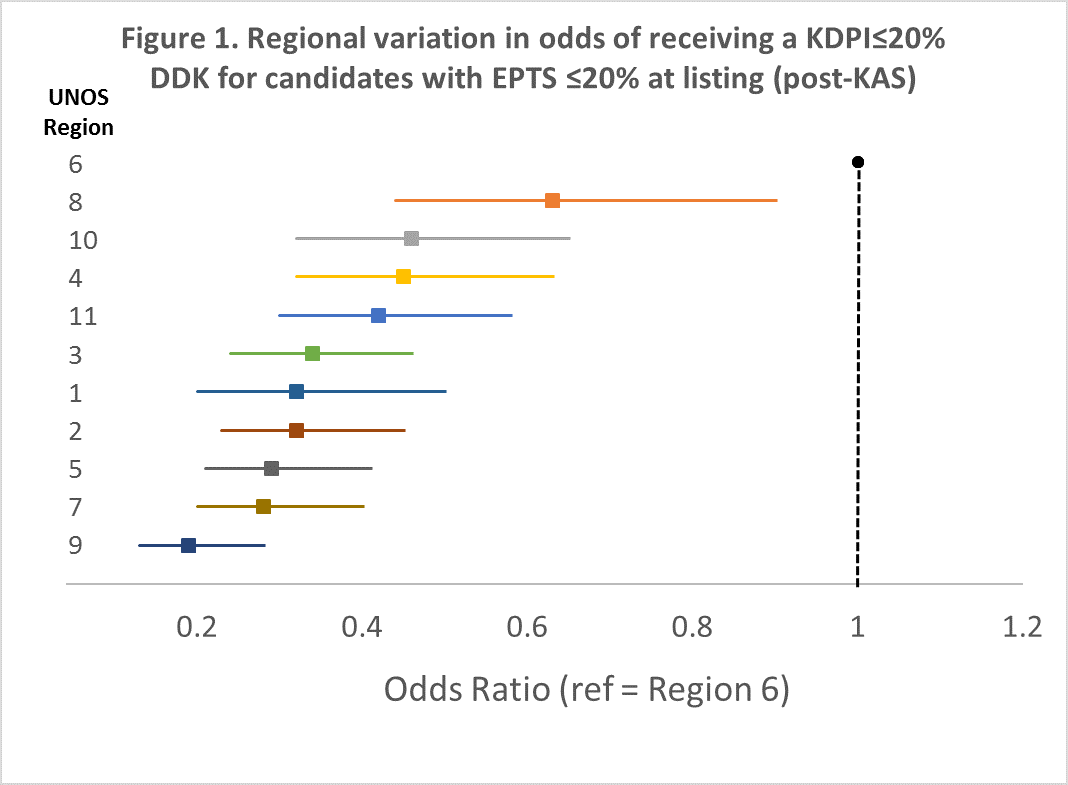Regional Differences in Transplantation for Expected Post-Transplant Survival Top 20% Candidates
Columbia University Medical Center, New York, NY
Meeting: 2019 American Transplant Congress
Abstract number: 211
Keywords: Allocation
Session Information
Session Name: Concurrent Session: Kidney Deceased Donor Allocation II
Session Type: Concurrent Session
Date: Monday, June 3, 2019
Session Time: 2:30pm-4:00pm
 Presentation Time: 2:30pm-2:42pm
Presentation Time: 2:30pm-2:42pm
Location: Ballroom B
*Purpose: The Kidney Allocation System (KAS) introduced the Expected Post-Transplant Survival (EPTS) score for deceased donor kidney (DDK) candidates to improve organ-recipient longevity matching. Candidates with the best 20% of EPTS scores are prioritized to receive DDKs with the best 20% kidney donor profile index (KDPI) scores. We sought to measure access to KDPI≤20% kidneys for EPTS≤20% individuals across the United States.
*Methods: We identified all incident adult DDK candidates waitlisted Jan 2015 through March 2018 using United Network for Organ Sharing (UNOS) Standard Transplant Analysis and Research data. We calculated candidate EPTS scores at listing and at the end of follow up [transplant, waitlist removal, or end of follow-up (3/31/18)], and KDPI scores for transplanted DDKs. We calculated the proportion of candidates transplanted, final EPTS, and KDPI of transplanted DDKs by EPTS listing group. We compared the odds of receiving a KDPI≤20% kidney across UNOS regions among candidates with EPTS≤20% at listing using logistic regression.
*Results: Among 117,042 incident DDK candidates, 29.2% had EPTS top 20 designation at listing and 15.7% of these were transplanted (compared to 15.9% of EPTS>20% transplanted) and 13.5% lost their top 20% status by end of follow up (median follow up 10.5 months). An examination of demographic factors demonstrated a higher proportion of female EPTS≤20% candidates in the KDPI>20% (47.3%) compared to the KDPI≤20% (41.5%) recipient group (p<0.001). Less than half (47.5%) of EPTS top 20 candidates who received a DDK received a KDPI≤20% organ, and 36.2% of KDPI≤20% organs went to patients with EPTS>20% including 41.7% in multi-organ transplants and 25.5% that went to patients with cPRA>97%. Odds of receiving a KDPI≤20% organ were significantly higher in Region 6 than any other part of the country, and lowest in Region 9 [odds ratio 0.19 (0.13-0.28)] [Figure 1].
*Conclusions: Over a third of KDPI≤20% kidneys go to patients with EPTS>20% on account of multi-organ allocation and prioritization for sensitized patients. There is considerable unexplained geographic variation in the odds of obtaining a KDPI≤20% organ for candidates with EPTS≤20% at listing that needs further study.
To cite this abstract in AMA style:
Husain S, King K, Tsapepas D, Dube G, Cohen D, Ratner LE, Mohan S. Regional Differences in Transplantation for Expected Post-Transplant Survival Top 20% Candidates [abstract]. Am J Transplant. 2019; 19 (suppl 3). https://atcmeetingabstracts.com/abstract/regional-differences-in-transplantation-for-expected-post-transplant-survival-top-20-candidates/. Accessed December 14, 2025.« Back to 2019 American Transplant Congress

